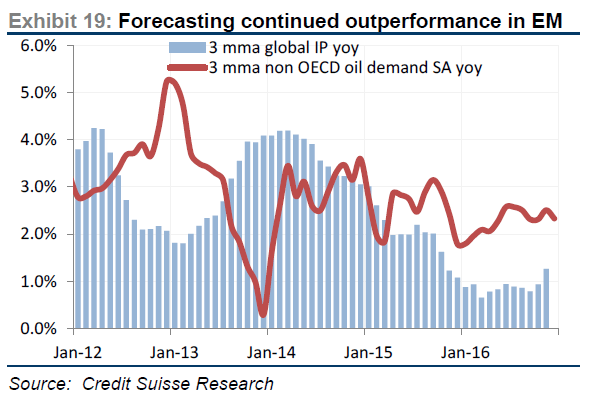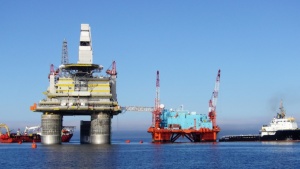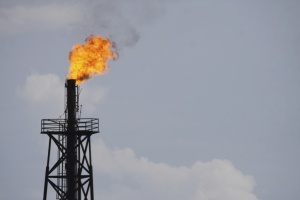Oil back below $40 as Iran dashes hopes for quick deal on output
/NewsOil fell around 3 percent on Monday after Iran dashed hopes of a coordinated production freeze any time soon, returning bearish sentiment over a supply glut that has sent prices crashing.
Global benchmark Brent crude futures LCOc1 fell back below $40 a barrel, trading at $39.27 at 1308 GMT, down $1.12 on Friday’s close. Brent hit a 12-year low of $27.10 in January.
U.S. crude CLc1 was down $1.09 at $37.41 a barrel.
“Oil is down because Iran said they would only join the output freeze group once they reached production of 4 million barrels a day,” said Tamas Varga, oil analyst at London brokerage PVM Oil Associates.
He was referring to comments by Iran’s oil minister Bijan Zanganeh on Sunday that the OPEC member would join discussions after its output reached that level.
Iran’s oil exports are due to reach 2 million bpd in the Iranian month that ends on March 19, up from 1.75 million in the previous month, he said.
Zanganeh met Russian counterpart Alexander Novak in Tehran on Monday but talks focused on long-running discussions about an oil and gas swap mechanism.
According to the Shana news agency, Zanganeh said Iran and Russia could cooperate on the swap, which would see Russia send oil and gas to northern Iran in return for Iranian supply to Russian customers in the Gulf.
Saudi Arabia appeared to have stuck to a preliminary deal with some other producers to freeze output, as its crude production held steady in February at 10.22 million barrels per day (bpd), an industry source told Reuters.
OPEC members and non-OPEC producers are likely to meet again in mid-April in Doha to discuss freezing output, OPEC sources told Reuters.
A March 20 meeting in Russia, which was part of an earlier plan, now looks unlikely.
Worries about demand fundamentals moved back into the spotlight as investment bank Morgan Stanley warned that a slowing global economy and high production would prevent any sharp rises in oil prices.
“Oil prices now seem to have bottomed, even though they are likely to stay subdued for the rest of this year before starting to move higher in 2017,” the U.S. bank said in a research note. It added that cheap oil had not provided the boost to growth that many had hoped for.
In a sign that investors are growing more skeptical about a rebound in oil prices, ICE data showed on Monday that speculators had cut net long positions in Brent crude by 9,500 contracts in the week to March 8.
Bjarne Schieldrop, chief commodities analyst at SEB Markets in Oslo, said a roughly 2 million bpd oil surplus would weigh down oil prices in the short term. The imminent restart of a pipeline between Iraq and Turkey and the breakdown in talks about a production freeze would add further downside, he said.
“We are likely to see $35 a barrel before we see $45 a barrel.”
Copyright: Reuters
Oil Producers Likely to Meet in April on Output Freeze
/NewsMajor oil producers are likely to meet in April to discuss a proposal to freeze output at January levels to stabilize the market, according to four Gulf OPEC delegates.
Ministers from some members of the Organization of Petroleum Exporting Countries had suggested that such a meeting would take place this month in Russia. The talks are now most likely to occur in Qatar’s capital Doha, said three of the delegates, who asked not to be identified because the matter isn’t public.
The probability that Doha will play to host the meeting is high as Qatar is president of the OPEC ministerial conference this year, even as Russia is the country that called for the meeting, two of the delegates said. The meeting may still not take place if there aren’t many important producers attending and agreeing beforehand to freeze production, three delegates said.
Saudi Arabia, Russia, Venezuela and Qatar in February proposed an accord to cap oil output and reduce a worldwide surplus. Crude prices extended gains after their initial meeting on Feb. 16 and have climbed more than 40 percent since slumping to a 12-year low in January. Prices may have passed their lowest point as shrinking supplies outside OPEC and disruptions inside the group erode global oversupply, the International Energy Agency said on March 11.
Russia-Iran Talks
Iran plans to boost crude output to 4 million barrels a day, the highest level since 2008, before it will consider joining other suppliers in seeking ways to re-balance the global oil market. Russian Energy Minister Alexander Novak met Monday with Iranian Oil Minister Bijan Zanganeh in Tehran.
Saudi Oil Minister Ali al-Naimi said last month in Houston that the process of devising a freeze agreement would continue with more discussions in March. Nigerian Petroleum Minister Emmanuel Kachikwu said two weeks later that talks would convene in Russia on March 20. Russia’s Novak told state television channel Rossiya 24 on March 4 that a meeting could take place between March 20 and April 1 in Russia, Doha or Vienna, where OPEC has its headquarters.
So far no countries have received invitations or an agenda for a meeting, the four OPEC delegates said.
Copyrigth: Rigzone
Iran Oil Lands in Europe for First Time Since Sanctions End
/NewsThe Monte Toledo oil tanker covered the uneventful voyage from Iran to Europe with a haul of 1 million barrels of crude in just 17 days, but its journey has been four years in the making.
On Sunday, the tanker became the first to deliver Iranian crude into Europe since mid-2012, when Brussels imposed an oil embargo in an attempt to force the Middle Eastern nation to negotiate the end of its nuclear program. The ban was lifted in January as part of a broader deal that ended a decade of sanctions.
The 275-meter (900-foot) tanker started offloading its cargo into a refinery owned by Cia. Espanola de Petroleos, near Algeciras, a few miles from Gibraltar. By midday, the vessel had already pumped to shore about a fifth of its cargo.
Jose Ramon Gomez Estancona, the captain of the Monte Toledo, said loading the crude at the Kharg Island terminal off Iran was a similar process to before the embargo. Staff at the port were “happy that normality was returning” to the country’s oil exports, he said.
In southern Spain, the tanker’s arrival was met with little fanfare. It was a quiet Sunday at the refinery, and for the workers, the Monte Toledo is just one of the eight or so vessels they expect to receive this month. By the time the refinery has taken in all the Iranian crude, another tanker from Algeria will already be waiting.
Rouhani Ambitions
Nonetheless, there’s a wider significance. As the Monte Toledo started to pump to shore through two 21-inch floating hoses connected to a giant buoy and a 1.8-kilometer submarine pipeline, Iranian President Hassan Rouhani declared in Tehran that more oil exports “will be added soon.”
Ali Tayebnia, the country’s minister of economy and finance, said Iran’s oil exports will “soon return” to 2 million barrels a day. “Arrangements have been made for the return of Iran to the market,” he said, according to Shana, the Oil Ministry’s news service.
Around Europe, other tankers with Iranian oil are close behind the Monte Toledo. In February, 29 vessels loaded crude from the Middle Eastern nation, according to data compiled by Bloomberg. Of those, three are heading toward Europe — the Eurohope tanker is sailing to Constanta, an oil port in Romania, and the Atlantas is on its way to France. Another one, the Distya Akula, is anchored at the mouth of the Suez Canal, and is likely to head into a Mediterranean port.
Export Recovery
The Monte Toledo and its companions are the vanguard in the return of Iran into the European oil market. Petro-Logistics SA, a Geneva-based tanker-tracking firm, estimated Iran exported about 1.4 million barrels a day in February, up 350,000 barrels a day from the average 2015 level.
Although the increase falls short of the 500,000 barrels a day that Tehran had promised, there are signs that exports into Europe will pick up this month.
“It does take a while to get those fields back up,” said Petro-Logistics director Daniel Gerber. “But I think they’re going to hit the increase of 500,000 barrels a day in March.”
Seth Kleinman, head of energy research at Citigroup Inc. in London, agreed, saying that in addition to higher export volumes this month, more countries were buying.
“You see tankers going to Spain, Romania, Tanzania, France and the U.A.E.,” he said. “You got an uptick to India in February too.”
Still, hurdles remain. Lingering banking restraints mean some customers are finding it hard to transfer payments for Iranian crude and National Iranian Oil Co. has offered to swap crude for gasoline to get deals done, according to local reports.
Iran will want to win back customers in Europe, where Russia, Saudi Arabia, Iraq and other rival suppliers stepped in after the embargo was imposed. Tehran also faces a rival unknown four years ago: the U.S. has started exporting crude and companies such as Exxon Mobil Corp. are shipping American oil into refineries in the Mediterranean.
Before the embargo Europe imported on average about 400,000 barrels of oil a day from Iran, according to the International Energy Agency. Cepsa alone was buying about 60,000 barrels a day. Total SA was among the biggest purchasers and the French company is waiting to receive the Atlantas tanker later this month at its refinery in Le Havre. Other European top buyers in the past, including Repsol SA, Eni SpA and Hellenic Petroleum SA, have yet to purchase any.
If all goes as Tehran has planned, the Middle Eastern country will boost its production back to the 3.6 million barrels a day it pumped in 2011. After the European embargo was imposed and the U.S. tightened other sanctions, Iranian output dropped to about 2.8 million barrels a day. In February, the nation pumped 3 million barrels a day for the first time since July 2012, according to data compiled by Bloomberg.
Copyright: Bloomerg
Brent oil rises to 2016 high; U.S. stocks gain
/NewsBrent oil prices hit a high for the year above $40 a barrel on Monday after data showed a smaller-than-expected build in U.S. crude stockpiles, helping U.S. stocks extend recent gains.
Brent was last up $1.87 at $40.59, while U.S. crude rose $1.58 to $37.50.
That lifted shares of energy stocks, which led gains in the S&P 500. The energy index climbed 1.5 percent. Biotechs also rallied, helping to support the broader market.
The Dow Jones industrial average was up 65.23 points, or 0.38 percent, to 17,072, the S&P 500 had gained 3.86 points, or 0.19 percent, to 2,003.85 and the Nasdaq Composite had added 9.78 points, or 0.21 percent, to 4,726.80.
MSCI’s all-country world stock index edged up 0.2 percent. In Europe, the pan-regionalFTSEurofirst 300 index provisionally closed down 0.3 percent.
The euro tumbled against the dollar before Thursday’s ECB meeting at which policymakers are expected to cut interest rates further into negative territory.
The euro was 0.5 percent lower at $1.0950 and down 0.7 percent at 124.34 yen. The U.S. dollar index was down 0.2 percent.
“The U.S. economy is doing relatively well. The dollar will likely hang on to its gains right now,” said Sireen Harajli, currency strategist at Mizuho Corporate Bank in New York.
In the U.S. bond market, U.S. Treasury yields rose in volatile trading as traders increased bets the Federal Reserve will raise interest rates this year in the wake of a strong February jobs report and ahead of a ECB meeting.
Friday’s payrolls data showed 242,000 jobs were created last month and assuaged fears the U.S. economy could be headed into recession. It also revived prospects of further Federal Reserve interest rate hikes this year, something markets had priced out.
The benchmark 10-year note’s yield rose to 1.918 percent, its highest in just over a month. It was last down 9/32 in price to yield 1.9127 percent, up from 1.883 percent late on Friday.
Copyrigth: Reuters
Oil rises 3% as Saudis advocate cooperation to stabilize market
/NewsBrent crude futures rose as much as 3 percent on Monday, adding to strong gains last week, on rising hopes that the market has bottomed out and as OPEC kingpin Saudi Arabia said it would work with other producers to limit oil market volatility.
Brent futures were trading at $36.15 per barrel at 11:26 a.m. ET (1626 GMT), up $1.05, or 3 percent. U.S. crude futures traded 98 cents, or 2.7 percent, higher at $33.67 a barrel
Since Feb. 11, the last time Brent was below $30, the crude benchmark has risen by 17 percent, though prices are still a fraction of the $115 of 20 months ago.
“The kingdom (of Saudi Arabia) seeks to achieve stability in the oil markets and will always remain in contact with all main producers in an attempt to limit volatility and it welcomes any cooperative action,” the Saudi cabinet said in a statement.
Saudi Arabia and several fellow OPEC members agreed with non-OPEC Russia this month to freeze output at January levels in an attempt to prop up prices.
Russian President Vladimir Putin called a meeting with top managers of his country’s leading oil producers on Tuesday.
However, Iran remains the main obstacle to a global output freeze because it is determined to ramp up supply after the country’s emergence from international economic sanctions in January.
On Monday Iran said it had increased exports steeply over the past month. Exports climbed as high as 1.75 million barrels per day, adding to an already oversupplied market.
“There is still a lot of downside risk … but the U.S. crude market seems to have passed the worst point and crude runs should start creeping higher, taking pressure off inventory levels,” said Richard Gorry, director of JBC Energy Asia.
U.S. producers cut the number of rigs drilling for oil for a tenth week running, taking the rig count to its lowest since December 2009.
A Reuters monthly poll showed on Monday that oil prices are expected to average a little more than $40 a barrel this year.
Copyright: CNBC
Houston energy leaders optimistic that next year will bring good fortune for industry
/NewsDespite heavy rains, more than 300 guests gathered at the Houstonian Hotel on Feb. 23 for HBJ’s Conversation with Houston’s Energy Leaders breakfast. The heavy rain served as a metaphor for the current state of the oil industry, and energy leaders offered their take on how to weather the storm for the rest of 2016.
The three panelists approached the current energy market with three different perspectives. Maynard Holt, co-president and co-head of investment bank Tudor, Pickering, Holt & Co., is bullish on the market over the next year, saying that oil could move to between $42 and $50 a barrel, which could open the market to a flurry of activity.
“We’ll be sitting here not too long from now saying, ‘Wow, that hurt, but it’s over and look at all the good things that are happening,'” Holt told the crowd.
And Ron Wagnon, president of Greenwell Energy Solutions, argued that the energy downturn will be a positive for the market in the long run and that it actually needed to happen. His company has been acquisition heavy over the past few years and isn’t shying away from a deal this year either.
“There’s a lot of opportunity out there,” Wagnon said. “The challenge in today’s market is creating a value for the businesses and trying to find flexibility — without access to cash — to do equity trades to bring businesses in the portfolio.”
One of the significant issues with today’s oil downturn is the difference in fortune between the upstream and downstream portions of the industry, Ken Medlock, senior director of the center for energy studies at Rice University’s Baker Institute, said. For those in upstream, the downturn has hit hard, however, the downstream market is doing well if not thriving. Regardless, the Bayou City will still continue to grow economically.
“Houston will weather this storm. The economy will continue to evolve, the energy space will continue to evolve, and Houston will be at the center of that,” Medlock said. “There’s been a lot of interest — particularly from the press — whether or not the transformation of the energy sector will make Houston obsolete, and I would say no, there’s no way that’s going to happen.”

Copyright: Houston business journal
Why the U.S. is cutting carbon emissions no matter what happens with the Supreme Court
/NewsLast week, the Supreme Court threw U.S. and international climate policy into turmoil by freezing President Obama’s Clean Power Plan while it is being challenged before the U.S. Court of Appeals for the D.C. Circuit. But matters took a turn over the weekend with the death of Justice Antonin Scalia, whose absence from the high court could mean that the plan will ultimately survive.
“If Scalia’s seat remains vacant when the Clean Power Plan reaches the high court, a 4-4 vote would result in an automatic affirmance of the D.C. Circuit’s decision on the rule,” says Jack Lienke, an attorney with the Institute for Policy Integrity at the New York University School of Law, by email. “We can’t know what the D.C. Circuit will decide, but supporters of the Clean Power Plan are optimistic — both because the D.C. Circuit panel, unlike the Supreme Court, denied motions to stay the rule and because the three-judge panel includes two Democratic appointees.”
So last week the Clean Power Plan seemed to be severely threatened – but now, not as much.
Despite this roller-coaster, though, one thing has not changed — the power sector in the U.S. is transforming in a way that will make the generation of electricity much less carbon-intensive in the future, the precise thing that the plan aims to achieve anyway. This is not a legal development, and not really a political one either. It is, in substantial part, a business decision.
Two recent sets of new data underscore this reality. The first, recently highlighted by the American Wind Energy Association, involves where the U.S. is adding new electricity generating capacity. In 2015, AWEA’s and other recent data suggest, wind led the way with 8.6 gigawatts (or billion watts) of new added capacity. Solar photovoltaics added 7.3 gigawatts (much of that on individual rooftops) and, in third place, came natural gas with 6 gigawatts.
The wind industry says another 9.4 gigawatts, meanwhile, are currently under construction, and 4.9 gigawatts on top of that are “in advanced stages of development.” Thus, the two biggest growth sectors for U.S. power are both renewable. Coal, by contrast, saw 14 gigawatts of plant retirements in 2015.
Similarly, the U.S. Energy Information Industry expects renewable energy to grow 9 percent in the U.S. in 2016, and to make up two thirds of added capacity (not unlike in 2015).
And this is just one of many, many indicators of a change underway in the U.S. power sector. Consider another: What leaders of the U.S. utility industry themselves think about the future.
The website Utility Dive has just published a survey of over 500 utility industry executives, from companies large and small, conducted in late 2015 and early 2016. 61 percent of respondents came from investor owned utilities, followed by 15 percent municipal utilities, 14 percent from electric cooperatives, and 10 percent public power companies. The companies were of all sizes, but 23 percent of those surveyed had customer bases of over 4 million people.
And the headline finding? “Nearly every” respondent felt that it was time for his or her company’s business model to change. And no wonder — the power industry is being upended by an insurgency of Nest thermostats, rooftop solar installations, customers who want home batteries and car chargers and much more.
Power companies are struggling to keep up with all of this — and the result of many, if not most, of these changes is that the utility industry is likely going to be less carbon intensive in the future, in part because you and I are going to both waste less energy and also get more out of the energy that we do use.
In particular, the survey shows, utility companies are wary of falling behind in a distributed energy world in which customers need them less because they can generate (with solar) and perhaps store (with batteries) much or even all of their own power. So companies want to become providers of these kinds of services, and so retain these customers.
Sure enough, when it comes to finding new sources of income and new businesses, “the most popular emerging revenue opportunities among respondents are energy management and efficiency services, community solar, and electric vehicle charging infrastructure, while green pricing programs and rooftop solar offerings were also popular,” the Utility Dive survey finds.
Oh, and then there’s how power will be generated at these sometimes massive companies in the future. The Utility Dive survey finds (and again, this is worth quoting in full):
Respondents believe utility-scale renewables, distributed generation and natural gas will increase in their utility’s power mix, while coal and oil will decline and nuclear will remain stagnant. Utilities expect stronger growth for large-scale solar and distributed generation than they do for wind or gas.
The number one thing that utility executives said their company should invest in more was energy storage, at 65 percent, followed by distributed generation, at 52 percent. Energy storage, at the grid scale, is a key technology that will allow for, among other things, more integration of renewable resources onto the grid.
In another notable statistic, meanwhile, when asked in what areas their companies’ power mixes would “significantly decrease” in the coming 20 years, 54 percent said coal, far more than for any other electricity source. No wonder that 41 percent of executive surveyed wanted the Clean Power Plan maintained as it is, while 29 percent thought it should be strengthened. It’s hard from such numbers to argue that the plan is strongly opposed by power companies.
It’s important to emphasize that these results are coming from leaders of an industry that is hardly known for risk-taking. Utilities have been, traditionally, heavily regulated incumbents who are slow to change.
But they’re also headed by leaders who can sense what’s happening out there and who would be foolish to ignore it. Which is why no matter what happens with the Clean Power Plan, all signs suggest our country will be using less coal — and a lot more wind and solar — in the future
Copyright: Washingtonpost
Energy, materials lead Wall Street gains as oil jumps
/NewsWall Street was higher on Monday as prices of crude oil and other commodities surged, pointing to an uptick in investors’ risk appetite following a rout in global markets.
Crude prices were up more than 5 percent after data showed a fall in U.S. rig counts and the International Energy Agency said it expects U.S. shale oil output to fall.
Prices of industrial metals such as Copper and Zinc were also up as investors worried about potential shortages.
Still, oil prices are hovering near levels last seen in 2003, with investors weighing the impact of a potential wave of defaults from energy companies on the financial sector.
Chevron’s (CVX.N) 1.4 percent rise provided the biggest boost to the energy sector .SPNY.
The S&P financial sector .SPSY, which has been the worst performer among the 10 major sectors this year, was up 1.79 percent on Monday as bank stocks recovered slightly.
“You’ve seen oil rebound today, which people are viewing very much as a kind of a green flag in the short-term to take on risk again to a certain degree,” said James Abate, chief investment office of Centre Funds in New York.
Abate, however, cautioned Monday’s gains should not be seen as the start of a long-term recovery.
“To me, this continues to be a counter-trend rally in the context of an intermediate to longer-term decline in the stock market. Our view is that this is nowhere near the resumption of a bull market,” he said.
At 9:37 a.m. ET (1437 GMT), the Dow Jones industrial average .DJI was up 179.29 points, or 1.09 percent, at 16,571.28, the S&P 500 .SPX was up 22.75 points, or 1.19 percent, at 1,940.53 and the Nasdaq Composite index .IXIC was up 52.02 points, or 1.15 percent, at 4,556.45.
All 10 major S&P sectors were higher, led by a 2 percent rise in both energy .SPNY and materials .SPLRCM sectors.
Investors are also keeping a close eye on the U.S. Federal Reserve for its next move on interest rates.
While Fed Chair Janet Yellen has indicated the central bank would stick to its rate hike program, policymakers appear at odds and traders have all but given up on a hike this year.
Shares of Fitbit (FIT.N) were up 4 percent at $16.24 ahead of its results later in the day.
Lumber Liquidators (LL.N) was down 20.8 percent at $11.26 after a report showed people exposed to some types of the company’s laminate flooring were more likely to get cancer than previously estimated.
Advancing issues outnumbered decliners on the NYSE by 2,487 to 279. On the Nasdaq, 1,906 issues rose and 375 fell.
The S&P 500 index showed 13 new 52-week highs and no new lows, while the Nasdaq recorded 24 new highs and nine lows.
Copyright: Reuters
Oil extends rally to $35 after Iran welcomes output freeze
/NewsOil rose to $35 a barrel on Thursday after Iran welcomed plans by Russia and Saudi Arabia to freeze output and an industry report showed a surprise drop in U.S. inventories.
The gain added to a more than 7 percent surge in the previous session, which came even though analysts said the market had overreacted to Iran’s support for the caps and the Russian-Saudi move would not likely reduce the global surplus.
Brent LCOc1 rose 60 cents to $35.10 a barrel by 1248 GMT, having closed 7.2 percent higher in the previous session. U.S. crude CLc1 gained 65 cents to $31.31.
“It’s a continuation of yesterday’s move,” said Carsten Fritsch, analyst at Commerzbank. “What we see still is extreme volatility. I would not be surprised to see prices retreating again by a big margin in coming days.”
Iranian Oil Minister Bijan Zanganeh met counterparts from Venezuela, Iraq and Qatar on Wednesday but did not say whether Iran would cap its output in keeping with the move by Russia and Saudi Arabia.

Copyright: Reuters

Latest News
 Breaking Barriers and Building the Future18 March, 2025
Breaking Barriers and Building the Future18 March, 2025 Fundamental factors to strengthen Pemex12 August, 2019
Fundamental factors to strengthen Pemex12 August, 2019 Offshore Project Development: The Road to First Oil26 July, 2019
Offshore Project Development: The Road to First Oil26 July, 2019







